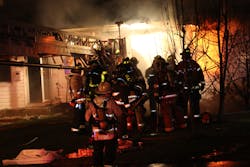Download the full PDF SMARTER: Advancing Health-Related Technology here.
Sudden cardiac events (SCEs) are the leading cause of line-of-duty deaths (LODDs) among firefighters in the United States, so it is obvious why there is such an appeal for electrocardiogram (ECG) monitoring during fire calls. The appeal for a wearable ECG device for firefighters largely comes from the desire to allow for early detection and intervention of SCEs.
As part of the SMARTER project, our team investigated the feasibility of using existing wearable devices in the fire service to monitor heart rate and rhythm. Perhaps not surprisingly, despite the appeal of ECG monitoring, we found several significant challenges. Here we outline several types of challenges that must be overcome before ECG monitoring will be feasible for routine use in the fire service.
Logistical challenges
The first area of concern is the logistical challenges, specifically, how to utilize the devices in a way that makes sense for the fire service. Common feedback from firefighters who tested the wearable products is that they don’t want to wear the devices 24/7. However, due to the nature of the emergency response, a use-model needs to be developed that would permit the firefighters to be monitored en route to a call and on scene. Almost certainly, a firefighter would not want to don another piece of equipment or layer of clothing once the alarm tones sound.
Perhaps the most significant logistical challenge is determining who should be monitoring the ECGs as they are being captured in real time. For most departments, having an individual on call to monitor incoming data would not be feasible; therefore, it may make sense to use a device that has automated arrhythmia detection software built in and can alert users/command staff of any abnormalities. The problem: The current state of arrhythmia-detection software is likely not precise enough for incident commanders to be willing to pull a firefighter from the job just because an arrhythmia was detected. Finally, for the products to be universally beneficial for the fire service, they must be cost-efficient so that they can be readily accessible for departments of all sizes to utilize.
Clinical challenges
The next layer of challenges for ECG monitoring for firefighters is the medical perspective. Currently, most wearable devices commercially available today utilize a single-lead ECG, not a standard 12-lead, to view the heart. The lead placements are non-traditional and differ from device to device. Additionally, even when you are able to obtain good ECG tracings, which is a major challenge in itself, a significant question remains: What arrhythmias are you able to detect, and which ones are clinically relevant? It is well known that many individuals have benign ECG abnormalities that have no clinical significance. Also, major life-threatening arrhythmias typically lead to a loss of consciousness, which means that they are detected right away during work at an emergency scene, without the use of ECG, so it is unclear whether the ECG would lead to earlier detection.
Contextual challenges
The definition of life-threatening arrhythmias (LTAs) is problematic in and of itself, as these classifications have origins in clinical settings where the subject is assumed to be resting in bed. This contextual assumption does not easily apply to the dynamic nature of the fire service and first responders.
While some LTAs, like asystole and atrial dysfunction, can be classified irrespective of heart rate, other rate-centric arrhythmias present additional challenges. Some very fit responders will have naturally low heart rates that may be confused with classic definitions of bradycardia, and others involved in stressful situations where high heart rates are a normal response to metabolic or adrenal stimulation could confound the classification of tachycardia. Circadian and hormonal cycles may also contribute to improper interpretation.
New personalized definitions addressing fitness and activity will be required to effectively address cardiac surveillance applications. Additionally, electrolyte imbalances from over/under-hydration should be considered in future designs as they can affect the ECG recordings.
Technological challenges
A final layer of challenge is in the technical realm. In order to effectively use wearable ECG technology, good signal quality is essential. Signal quality could suffer for a multitude of reasons, ranging from improper placement of the electrodes, to poor conductivity with the skin, to movement artifact (a type of interference due to movement of the body, which produces false or messy ECG tracings), to interference from SCBA straps or electronic devices. Because the lead placements are non-traditional, and vary between devices, there are individual technological challenges that exist as well. For example, some of the commercially available devices would require the firefighter to remove their gloves and remain still for 60 seconds while an ECG is recorded—obviously not ideal for use during fireground operations. Further, devices need to be able to accurately interpret the ECG signal from movement artifact or interference. The cleaning of data that needs to occur for some single-lead ECGs to be usable is not time-efficient enough to be of use for real-time monitoring. Algorithms that make rhythm assumptions to track beats through noisy periods can be confounded, producing erroneous rate metrics.
Using ECG monitoring now
Despite the challenges to using wearable ECG monitors on the fireground at this point, there are some appropriate and available uses for ECG now. Current technologies may be useful in a rehab setting where firefighters are in a more controlled stable environment. This is a period when firefighters may present rhythm dysfunction exacerbated by dehydration and heat. Whenever it is available, a 12-lead ECG and oxygen saturation (SpO2) monitoring is still strongly preferred for anyone exhibiting cardiac symptoms.
With the rapidly evolving world of technology, it is possible that ECG monitoring may progress to a point that it could support decision-making on the fireground. For now, a full 12-lead ECG stress test should be conducted for individuals at elevated risk before firefighters respond to a fire. This should be done as part of a routine comprehensive medical evaluation, and should be done to ensure that firefighters are safe and healthy enough to operate on the fireground. The fireground is no place to be performing a stress test with new technology and nobody interpreting the results!
Read more about the SMARTER project and related studies at skidmore.edu/responder.
More from SMARTER: Advancing Health-Related Technology
Andrea Wilkinson
Andrea Wilkinson, MS LAT/ATC, serves as project manager for the First Responder Laboratory at Skidmore College. She is certified and licensed in athletic training and cardiac rehabilitation, and has extensive clinical experience in cardiac care and sports medicine. Wilkinson has a special interest in preventative medicine for the tactical athlete.
John Ames
John Ames is an independent analyst and engineer focusing on advanced bio-signal processing and sensor innovation. He has successfully developed consumer, medically regulated and military health assessment systems. His background includes both research and commercialization.







